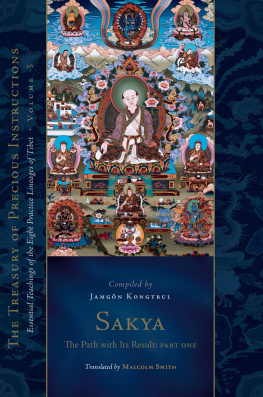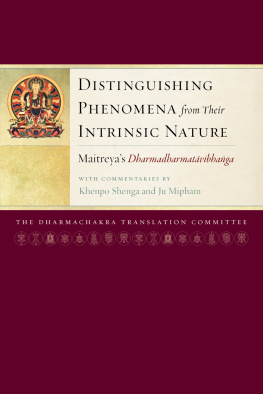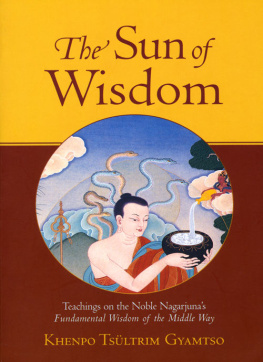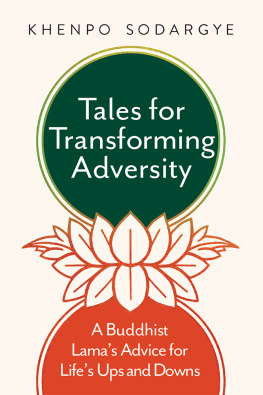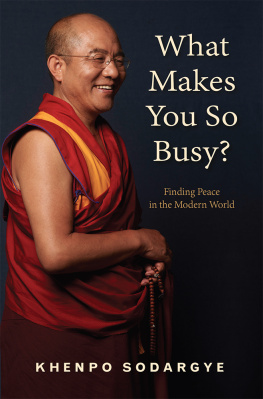
WISDOM PUBLICATIONS
199 Elm Street
Somerville, MA 02144 USA
wisdompubs.org
2017 Khenpo Sherab Zangpo
All rights reserved.
No part of this book may be reproduced in any form or by any means, electronic or mechanical, including photography, recording, or by any information storage and retrieval system or technologies now known or later developed, without permission in writing from the publisher.
Library of Congress Cataloging-in-Publication Data is available.
LCCN 2017018044
ISBN 978-1-61429-415-3 ebook ISBN 978-1-61429-423-8
21 20 19 18 17
5 4 3 2 1
Cover design by Jim Zaccaria.
Editors Preface
At some point of our life, we have all asked ourselves what it takes to be happy and many of us spend so much time investigating this question. In this book, Khenpo Sherab Zangpo offers us valuable assistance.
Khenpo Sherab Zangpo is a lineage-holder in the Tibetan Buddhist tradition of the Great Perfection and a heart-son of His Holiness Jigme Phunstok Rinpoche, one of the most influential Buddhist leaders of our time and one who ushered in a renaissance of Tibetan Buddhism in Tibet in the 1980s. Khenpo, a tireless teacher and writer, is the author of several highly acclaimed books in Chinese, but The Path: A Guide to Happiness is his first book published in English. In it he offers theory and practical advice, showing readers how the teachings of the Buddha lead to lasting happiness through training and transforming our minds.
What makes the book especially compelling is the way Khenpo blends together the timeless wisdom of Buddhism with his own compassionate appreciation of todays life, making the teachings both close to our life and practical to our daily problems and mental perplexity. The book is fascinating to read, in part because of the way Khenpo illustrates the teachings with experiences from his own life and with endearing stories about the remarkable teachers he has met, including His Holiness Jigme Phuntsok Rinpoche.
It is our hope that this warm and beautifully written book may help readers achieve not only long-sought happiness but also lasting happiness as well.
We would like to dedicate to Khenpo the following verse from The Long-Life Prayer for Khenpo Sherab Zangpo written by His Holiness Kyabgon Gongma Trichen Rinpoche:
To Amitayus of the Buddha of Immeasurable Life, master of the ten powers,
To Padmasambhava of Guru Oddiyana Vajradhara, realizer of the five wisdoms,
We pray for the blessing nectar rain of fortune, longevity and wisdom,
Always bestowed by you and falling swiftly like water running off a deep cliff.
Sherab Zangpo, the holder of the Tripitaka, the very essence of Buddhas words,
Help beings dispel their darkness of ignorance and delusion.
He is the source of all virtues and good qualities, and shines like a hundred thousand suns together.
May this sun-like teacher, who is wise, disciplined and kind, long remain.
He the noble one is like the eye of the world, possessing transcendental wisdom and connecting people in all directions,
To enlighten them and lead them to liberation just like the sun making a hundred petals of a lotus open.
May obstacles impeding the longevity of this great teacher be removed speedily,
And his kind deeds and merits continue shining in every corner of the four continents.
PART 1
Life in the Eyes of a Buddhist
Happiness
One of my students once asked me how to be happy, and I thought the question was easy to answer: by letting go of attachment one achieves happiness. But over time I found that such a straightforward answer does not work for everyone. What exactly is attachment? How do we let go of it? These are issues worthy of further examination. So when I face the same question nowadays, I reply by asking, How are you feeling right now? Happiness, after all, is ones state of mind.
Sometimes people are not unhappy, but they perceive themselves as being that way. If you observe how your mood changes over time, you will find that emotions affecting your mood are like clouds changeable and easy to disperse. From afar, clouds can appear solid as if you could walk on them. But if you reached them, of course you could not. Even so, clouds often build up in the sky. Likewise, emotional clouds too often gather in us to shape our state of mind. If our emotions are dominated by positive ones like joy and contentment, we feel happy.
What brings happiness? The relief of pain and suffering makes us happy. Do not regard happiness as something that can only be achieved through daunting effort. Happiness is discoverable anywhere, even in the life of an ordinary person. A drink makes you happy when you are thirsty. A hearty meal makes you happy when you are hungry. A seat to sit on while riding the subway makes you happy after a long, exhausting day. And the extraction of a decaying tooth makes you happy if you have been suffering from a toothache for days.
Happiness can also be a cool breeze on a summer night, or the shade of a tree that shelters you from the scorching sun. Happiness can even be found in the simplicity of a single breath. Meditating on ones own breath is a common technique taught to beginners. By mentally following each round of inhalation and exhalation in quiet awareness, we try to bring our mind to a neutral and tranquil state, which allows us to experience inner bliss. Sometimes, happiness is delivered by the most modest changes in our lives. The respiratory symptoms associated with the common cold such as nasal congestion or a runny nose can be maddening after experiencing them, just being able to breathe normally can generate a sense of relief so powerful it borders on joy.
Happiness is always close at hand, but we are either too restless to be aware of it, or it is too fleeting to be relished to the fullest. If we can look inward and observe our emotions and thoughts as much as we examine the blemishes on our faces, it will not be difficult to sense the happiness present in every moment. If we do not entrust happiness solely to the ephemeral pleasures and thrills that the material world brings, our sense of happiness can be both extended and expanded.
The root of our unhappiness, as the Buddha says, comes from attachment attachment to a self and attachment to things around us. We believe in an inherently existent self this is my physical body, my idea, my house, my friend, and so on but that belief is a miscomprehension of our true nature. The second-century Indian Buddhist master Nagarjunas Fundamental Verses of the Middle Way and the eighth-century Indian Buddhist master Shantidevas The Way of the Bodhisattva provide detailed instructions on how to eliminate the attachment to a self. In short, there is no such self that exists intrinsically from the Buddhist point of view.
Is the person you see in the mirror every morning really you? A biology teacher will tell you that our bodies undergo constant metabolism, which leads to the continuous death and renewal of many of our cells. Moreover, your image in the mirror changes constantly. If friends who have not seen you for decades meet you again, they may hardly recognize you at first sight. The only reason that they can still identify you is that you do not exist in isolation and your associations with them and the world around you leave traces that connect your past with the present. After all, nobody in this world comes out of a void. Our relativity our links with people and the environment is what allows us to be identified and recognized. Once we see such relativity, we will start to understand the pointlessness of building a wall between the outer world and ourselves. The sense of frustration induced by the futility of doing so can only make us unhappy.
Next page


